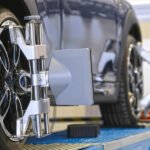

A Deep Dive into the World of Brake Pads
Have you ever stopped to think about what’s behind the smooth, confident halt of your car every time you hit the brakes? It’s all thanks to the often overlooked heroes of the braking system: brake pads. But these vital components have a fascinating history and have evolved significantly since their inception. Let’s take a closer look at the intriguing world of brake pads, from their origins to how they function, and the exciting advancements driving their future.
From Wooden Blocks to High-Tech Wonds:
The journey began with primitive wooden blocks rubbing against wheels in horse-drawn carriages. The early 20th century saw leather take over, offering slightly better performance. However, both materials were prone to wear and tear, posing safety concerns.
Asbestos revolutionized the scene in the 1900s with its superior heat resistance and stopping power. Unfortunately, its health risks were later discovered, leading to a well-deserved ban in the late 1970s. The ban on asbestos sparked a search for safer options. The 1980s and 1990s saw the rise of semi-metallic, organic, and ceramic compounds, each with its own strengths and weaknesses.
Today’s Cutting-Edge Pads:
Today’s brake pads are engineering marvels. Among them, ceramic pads stand out for their durability and ability to produce minimal dust, making them a popular choice. Furthermore, advancements in brake pad technology have led to the development of low-noise formulas and the use of eco-friendly materials such as bio-based composites. These innovations are revolutionizing the braking industry, offering drivers enhanced performance and environmental sustainability.
How Do Brake pads Work?
When you press the brake pedal, hydraulic pressure forces the pads against the rotors, creating friction that slows down the wheels. Different materials offer varying levels of grip, heat resistance, and noise generation.
The Future of Braking:
The future holds exciting possibilities. Carbon fiber and silicon carbide are being explored for their exceptional heat resistance and lightweight properties. Regenerative braking systems, which capture energy during deceleration, are paving the way for improved efficiency.
What Can Make Brake Pads Fail ?
Brake pad failure can be caused by various factors, each of which can compromise the safety and performance of your vehicle’s braking system. Excessive wear is a common issue, often resulting from prolonged use or aggressive driving habits. Additionally, contamination from substances like oil or coolant can degrade the friction material of the brake pads, reducing their effectiveness over time. Another culprit is overheating, which can occur during prolonged braking or driving in hilly terrain. Signs of brake pad failure may include grinding noises when applying the brakes, a noticeable decrease in stopping power, and vibrations felt through the brake pedal or steering wheel. It’s crucial to address these warning signs promptly to prevent further damage to your vehicle and ensure your safety on the road. Regular inspection and maintenance of your brake system can help identify potential issues early and prevent costly repairs down the line.
Maintaining The Brake Pads
Maintaining your car regularly is paramount to ensuring its longevity and safety on the road. Among the various components that require attention, the brake system stands out as a critical area that demands meticulous care. Regular inspections of your brake pads for signs of wear and tear are essential in detecting potential issues early on. By adhering to manufacturer-recommended intervals for brake pad replacements, you can prevent premature wear and maintain optimal braking performance. Additionally, using high-quality brake fluid is vital for preserving the integrity of your braking system and preventing issues such as brake fade and corrosion. Investing time and resources in proper brake maintenance not only enhances your vehicle’s performance but also contributes to the safety of you and your passengers. Remember, prioritizing the upkeep of your brakes is a proactive measure that can prevent costly repairs and ensure smooth, reliable stops every time you hit the road.
Add a comment Cancel reply
Categories
- Car Gadgets (17)
- Car News (33)
- Car Reviews (43)
- Car Wars (7)
- Mechanicals (32)
- Uncategorized (2)
Recent Posts
About us

Popular Tags
Related posts


Essential Car Repair Skills Every Driver Should Know

All About Wheel Balancing








